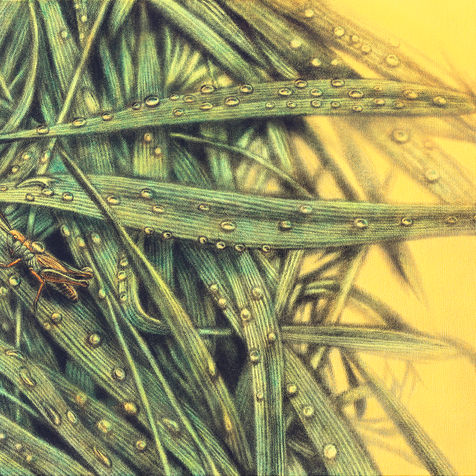
Japanese sumi ink & acrylic
Life-Scape
I often wonder—are there truly any places untouched by human presence? How has the landscape shifted and transformed through our intervention? Or conversely, how has the landscape shaped the rhythms of human life? The Industrial Revolution, born in modern Britain and sweeping across the globe, established a new world order rooted in an almost blind faith in science and technological progress—a faith that has endured from the twentieth century to the present day. Regardless of ideology, it has come to resemble a new global religion, universally desired and rarely questioned.
Yet even in its nascent stages, voices rose in resistance—voices that sought to re-examine the essence of the relationship between humanity and nature. These echoes have reverberated through time, evolving into today’s ecological movements. And now, as we stand on the threshold of a Fourth Industrial Revolution—an era in which Artificial Intelligence threatens to surpass human intellect and reshape societal order—we must once again ask: are there any realms, whether of knowledge or of land, where human feet have yet to tread?
My own endeavour is to gather the daily lives of people—rooted in their unique histories and cultures—and to weave them into a narrative through careful visual depiction, aligned with contemporary understanding. In doing so, I seek to generate new stories through my own visual language. These are not mere landscapes, nor simple reproductions of photographs, but narratives born of the post-21st century. They may well be my personal inquiry into the possibility of what Jean-François Lyotard once called the “grand narrative.” Lyotard famously declared the end of grand narratives—those overarching systems of meaning encompassing society, history, knowledge, and values, constructed and widely believed throughout human civilisation. Yet, half a century on, humanity seems poised to discover a new grand narrative within AI itself.
Around the time Lyotard published “The Postmodern Condition”, a Japanese artist named Morikazu Kumagai passed away at the age of 97. He is a figure I deeply revere—known as “the painter of the garden” and a post-war icon of Japanese art. His life continues to move me profoundly. He lived with quiet simplicity, loving only his garden and his art. Observing the flowers, insects, and small creatures he encountered there, he distilled them into works of simple form, attuned to the shifting light and breeze of the seasons. It is said that in the final thirty years of his life, he rarely left his home, living almost like a sage, as if his garden were the entire universe. Kumagai once said, “Even without travelling, if you look at insects, flowers, and sunlight, you can see the cosmos.” Within this lies a realm of expression that no algorithm can parse—an expressive domain forever beyond the reach of AI.
Moreover, I believe that a work of art must become what Umberto Eco once called an “open work.” That is, while visually articulating a concept, it must contain within it layered veils of meaning, permitting interpretation by all, without compromising the integrity of the artist’s intent. Such a work embodies the very fluctuation of complex systems. My own technique, developed through the use of Japanese sumi ink and acrylic in intricate line-hatching work, weaves these veils of meaning through countless strokes. It is nothing less than a relentless pursuit of uncharted territory—territory inaccessible to algorithmic logic.
In this way, I seek to crystallise the “now” as it appears to my eye within the flow of history, and to evoke the core memory of human endeavour that stretches back to antiquity. What emerges is a narrative in visual language—a story that resonates with the enduring pulse of life. This, to me, is the essence of the Life-Scape I strive to create.































